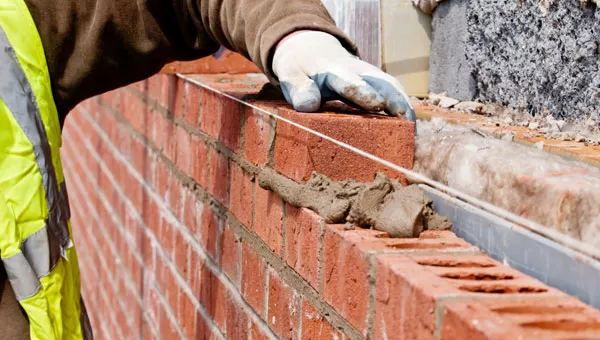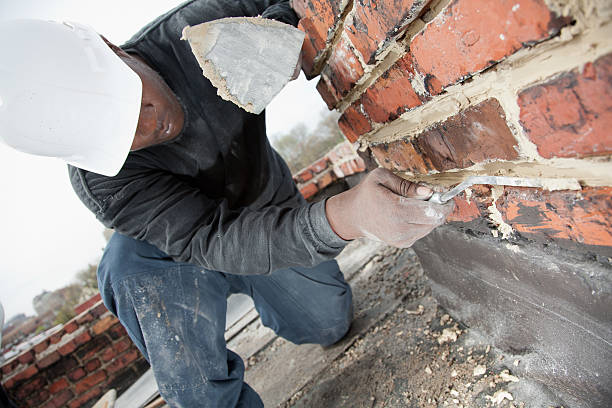Schedule a Chimney Sweep Today for a Clean and Safe Fireplace
Schedule a Chimney Sweep Today for a Clean and Safe Fireplace
Blog Article
Opening the Keys of Sustainable Masonry Building Practices for Eco-Friendly Buildings
Among the myriad techniques to eco-friendly structure, sustainable masonry construction stands out as a time-tested and sturdy technique that holds a wide range of untapped capacity. From the choice of products to ingenious construction strategies, the secrets to accomplishing sustainability within masonry building are complex and interesting.
Benefits of Sustainable Stonework Building
Embracing sustainable stonework building and construction techniques not only reduces ecological influence yet additionally uses long-lasting economic benefits to home builders and neighborhoods. By using materials like recycled blocks, blocks, and stones, builders can significantly reduce the carbon impact of their projects while advertising resource performance. Furthermore, lasting stonework building methods, such as proper insulation and thermal mass residential or commercial properties, can enhance power efficiency within structures, causing decreased functional costs with time.
Furthermore, the resilience and resilience of stonework structures contribute to long-lasting economic advantages. Structures built using lasting masonry techniques commonly need less repair and maintenance, equating to set you back financial savings for contractors and residential or commercial property proprietors. The long life of masonry materials also guarantees that structures remain steady and secure, decreasing the demand for frequent renovations or substitutes.
Eco-Friendly Masonry Products
Utilizing green masonry products is an essential step in the direction of enhancing the sustainability of building methods and decreasing ecological effect while optimizing long-term financial benefits. Sustainable stonework materials are sourced, generated, and used in a manner that reduces total environmental impact. Products such as recycled bricks, reclaimed rock, and lasting cinder block are becoming increasingly popular choices for eco-conscious contractors. Recycled bricks, for instance, not only divert waste from garbage dumps but likewise require less energy to create compared to new bricks. Recovered stone provides an unique aesthetic charm while decreasing the demand for brand-new quarrying. Lasting concrete obstructs include recycled accumulations and might include better insulation homes, adding to energy effectiveness in buildings.
Furthermore, all-natural materials like adobe, rammed earth, and straw bundles offer outstanding thermal mass residential or commercial properties, decreasing the demand for home heating and cooling power. These materials are often in your area available, advertising regional economic situations and decreasing transportation-related carbon emissions. By selecting green stonework materials, construction jobs can significantly minimize their ecological impact and add to the production of much healthier, much more lasting constructed settings.
Energy-Efficient Stonework Methods
Energy effectiveness plays a vital duty in improving the sustainability of masonry building methods. By applying energy-efficient stonework techniques, home builders can considerably decrease the general energy consumption of a structure, causing reduced functional prices and a smaller environmental impact. One essential energy-efficient masonry strategy is using thermal mass, which entails including dense products like concrete or brick into the structure's structure to absorb and keep warm. This assists regulate indoor temperature levels, lowering the demand for mechanical home heating and cooling systems.

Innovations in Sustainable Stonework
Recent advancements in sustainable stonework practices have brought around innovative techniques that are reshaping the construction market. One such innovation is the development of self-healing concrete, which uses germs installed within the concrete to heal click here to find out more fractures autonomously. This development not just decreases upkeep prices but additionally enhances the sturdiness of stonework frameworks, adding to their sustainability.
An additional remarkable advancement is using recycled aggregates in masonry construction - masonry contractor. By including products such as crushed ceramic waste or recycled glass into concrete blends, contractors can decrease the ecological influence of construction projects while maintaining structural honesty. This method not just draws away waste from garbage dumps however additionally saves natural deposits, making it a crucial development in lasting stonework building
Moreover, the combination of digital layout tools, such as Structure Information Modeling (BIM), is changing the method stonework structures are intended and constructed. BIM permits for more specific calculations, lowered material wastefulness, and enhanced energy performance, eventually bring about more lasting structure practices. These developments jointly symbolize an appealing future for sustainable stonework building and construction in the period of eco-friendly structures.
Future Trends in Masonry Sustainability
With the ingenious strides made in lasting stonework methods, the future patterns in stonework sustainability are poised to further reinvent the construction industry. Among the essential fads shaping the future of stonework sustainability is the internet enhanced assimilation of technology. Developments such as Structure Information Modeling (BIM) and online fact simulations are being made use of to optimize masonry building processes, bring about reduced material waste and enhanced energy performance in structures.
Furthermore, the development of novel sustainable products is readied to play a significant role in improving the eco-friendliness of masonry building. masonry contractor. Technologies like self-healing concrete, recycled accumulations, and bio-based binders are acquiring traction for their capacity to decrease ecological effect while keeping structural honesty

Final Thought
To conclude, sustainable stonework building and construction methods offer numerous advantages for eco-friendly structures. By using environmentally friendly materials and energy-efficient strategies, stonework can add to a much more sustainable built environment. Technologies in lasting stonework are constantly being developed to additionally improve the ecological sites performance of structures. Looking towards the future, the pattern of stonework sustainability is expected to expand, resulting in more eco-friendly and energy-efficient building and construction practices in the years to come.
Report this page